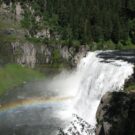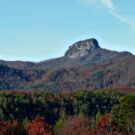Mississippi, The Magnolia State
by Sandra Merville Hart Mississippi’s official nickname is The Magnolia State. Mississippi schoolchildren chose the name in a 1900 election. Runners up were the cotton blossom and the cape jasmine. The early history of Mississippi The Natchez, Chickasaw, and Choctaw were some of the Native Americans that lived in the Mississippi area when the Spanish explorer, Hernando de Soto, arrived in 1540 and claimed the area for Spain. More than a century later, the French explorer, La Salle, claimed the area for France. In 1699, Pierre d’Iberville built the first settlement in Mississippi, Fort Maurepas. Mississippi becomes a State Mississippi became the twentieth state on December 10, 1817. The capital is Jackson. Top producer of cotton Cotton became an important crop...
Read MoreColorado, The Centennial State
by Sandra Merville Hart Colorado’s nickname is The Centennial State. It became the 38th state in 1876, the one-hundred-year anniversary of an important national event – the Signing of the Declaration of Independence. Colorado’s early history Comanche, Cheyenne, Arapaho, Kiowa, and Ute Native American groups already lived in the Colorado area when Spanish explorers arrived in the early 1700s, but that didn’t prevent Spain from claiming the whole region. The French later claimed part of the territory. In 1806, Lieutenant Zebulon Pike led the United States’ first expedition to Colorado searching for the southwestern border of the Louisiana Purchase. When he crossed into Spanish territory, they arrested him. Fur trappers came to the territory searching for...
Read MoreNorth Dakota, The Peace Garden State
By Sandra Merville Hart North Dakota is called the Peace Garden State for the International Peace Garden along its border with Manitoba, Canada. The beautiful lakes, groves, trees, and flowers are a celebration of the friendly relationship between the two countries. The state gets its name from a local Native American tribe called Dakota. The area of North Dakota and South Dakota was known as the Dakota Territory before they became states. Sacagawea To explore lands recently bought in the Louisiana Purchase and to search for a way to the Pacific Ocean, Meriwether Lewis and William Clark led an expedition west in 1804. Their trip led them to North Dakota where they built Fort Mandan to stay for the winter. Lewis and Clark met Sacagawea, the daughter of a Shoshone...
Read MoreIdaho, The Gem State
by Sandra Merville Hart Idaho’s nickname is The Gem State. The state’s mountains contain silver, gold, copper, and cobalt to name a few. The state gem, star garnets, are usually a purple or plum color. Other rare gems found in Idaho are opal, jade, jasper, and topaz. Idaho’s early history The Lewis and Clark Expedition, led by Meriwether Lewis and William Clark, arrived in the area known as Idaho in 1805. Because the expedition found thick forests, fur traders began to travel there. A Canadian company opened the first trading post in region of Idaho, Oregon, and Washington in 1809. Fur traders trapped animals and exchanged with Native Americans so successfully that they greatly reduced the number of those animals by the 1840s. Two trading posts remained...
Read MoreNew York, The Empire State
by Sandra Merville Hart New York is known as the Empire State because of its significance to the United States and the world. New York’s early history In 1624, Dutch settlers came to the area of Governors Island in New York. They called the whole region, which also included New Jersey, New Netherlands. Purchase of Manhattan Island The Dutch settlers purchased Manhattan Island from the Lenape Indians for 60 guilders ($24) in trade goods. Farm equipment, tools, cloth, and wampum (shell beads) were goods included in the trade. First president inaugurated in New York In New York City, our first president, George Washington, stood on the balcony of Federal Hall and placed his hand on a Bible to take the oath of office on April 30, 1789. He wore a dark brown suit...
Read MoreNorth Carolina, The Tar Heel State
by Sandra Merville Hart North Carolina’s large pine forests made them the world leader in production of tar, pitch, rosin, and turpentine from 1720 to 1870. The nickname, The Tar Heel State, seems to date back to the Civil War. North Carolina soldiers stayed and bravely fought in a fierce battle when soldiers supporting them fled. After the battle, a North Carolina soldier joked with one of fleeing soldiers that Jefferson Davis planned to put tar “on you’ns heels to make you stick better in the next fight.” North Carolina’s early history In 1629, England’s King Charles I divided Virginia south of Albemarle Sound and called the area Carolana. People from Virginia moved there in 1653 and settled the area. The first English baby born in the...
Read More









